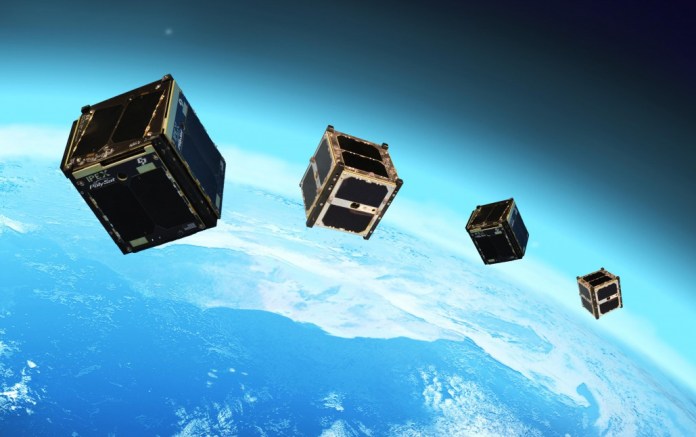NSR’s latest report, Global Satellite Manufacturing, and Launch Markets, 11th Edition, see a post-pandemic rebound driven by constellations, innovative technologies, and new services offerings. Over the next 10 years, satellite manufacturing and launch order volumes reach nearly 24,700. Upcoming deadlines for international regulatory filings, strong investments from public and private investors, and the associated capacity influx by Non-GEO HTS will drive significant orders and launches through 2030.
“With several ambitious and well-funded programs aiming to meet international deadlines under immense financial pressures, constellations will drive satellite manufacturing and launch volumes,” states NSR Principal Analyst and report lead author, Dallas Kasaboski. “While larger GEO satellites take on more complexity via software-defined and multi-mission payloads, other applications, like In-Orbit Servicing (IoS), Space Situational Awareness (SSA) and IoT drive additional market growth.”
“The demand for new types of spacecraft and services in orbit is increasing,” adds NSR Analyst and co-author Hussain Bokhari. “The drive for SSA continues, focusing on protection of assets via more satellites for Gov/Mil customers. Meanwhile, research and development satellites will help smaller players enter the market.”
Commercialization of crew and cargo flights also see a positive market outlook. Regardless of the forthcoming ISS decommissioning, Crew & Cargo missions dominate the Launch Market, generating the most revenue over the next decade, with private operators increasingly in the foreground.
As governments and private companies pick up the pace, the Beyond Earth and Deep Space Exploration markets will be greenfield opportunities. Upcoming deadlines for international regulatory filings, strong investments from private investors, and the associated capacity influx by Non-GEO HTS will drive significant levels of orders and launches through 2030.
About the Report
NSR’s Global Satellite Manufacturing and Launch Markets, 11th Edition report (GSMLM11) offers the most comprehensive analysis available of the manufacturing and launch market in the next decade across 5 regions, 7 applications, and 5 mass ranges. The report takes a deep dive into where sector demand is leading in terms of complexity, launch requirements, and operations. The report provides decision-makers business-critical metrics into the traditional and NewSpace markets – their interactions, impacts, developments, and trends through to 2030. For additional information on this report, including a full table of contents, list of exhibits and executive summary, please visit www.nsr.com
Companies Profiled or Mentioned in this Report:
Aerial & Maritime Ltd, Airbus, Aistech Space, Alpha Space Test and Research Alliance, Altius Space Machines, Amazon, Analytical Space, Spaceflight Systems, Applied Defense Solutions, Aquarian Space, Arctic Space Technologies, Ariane Group, Arianespace, Astra, Astranis Space Technologies Corp., Astro Digital, Astrobotic, Astrocast, Astrome, Astroscale, Atlas Space Operations, Audacy, AxelSpace, Ball Aerospace, Black Sky Inc., Blacksky, BlinkAstro, Blue Canyon Technologies, Blue Origin, Boeing, Bradford ECAPS, Bradford Space, C6 Launch Systems, Canadensys Aerospace Corp., Canadian Space Agency (CSA), Canon, Capella Space, Ceres Robotics, CGWIC, CisLunar Industries, ClearSpace SA, CNES, CNSA, Cobham AES Division, DARPA, Dauria Aerospace, Deep Space Systems, Deimos, DLR, D-Orbit, Dynetics Inc., EarthCube, Ericsson, ESA, European Commission, Eutelsat, ExactEarth, Exoanalytic Solutions, Firefly Aerospace Inc., Fleet Space Technologies, General Atomics, GeoOptics, GEOShare, GHGSat, Global Eagle, Global Star, GOMSpace, Goonhilly Earth Station, Groundspace, Hanwha Systems, HawkEye360, HEAD Aerospace Group, HeliosWire, Hera Systems, Hiber, Honeybee Robotics Spacecraft Mechanisms Corporation, HPE, Hughes, IBM, ICEYE, Icon Build, Infinite Orbits, Infostellar, Inmarsat, Intelsat, International Launch Services, Intuitive Machines, Iridium, ISISpace, ISpace China, ispace Inc., Israel Aerospace Industries, ISRO, KACST, Kepler Communications, Kineis, Kratos Defense & Space, KSAT, KUBOS, L3 Applied Defense Solutions, L3Harris Technologies, Lacuna Space, LaserLight Communications, LaserLight Solutions, Leafspace, Leidos Holdings, LEOCloud, LeoLabs, LeoSat, LeoStella, Lockheed Martin, Lockheed Martin Corporation, Loft Orbital, Los Alamos National Laboratory, Lyteloop, Masten Space Systems, Maxar, MDA, Microsoft, Mission Control Space Services, Mitsubishi Electric, Mitsubishi Heavy Industries, Mitsui & Co., Momentus, Momentus Space, Moon Express, Moonscape, Mynaric, Myriota, Nano Avionics, Nanoracks LLC, NASA, NASDA, Nokia, Northrop Grumman Corporation, NorthStar Earth & Space Inc., Novawurks, NPO Lavochkin, NSLComm, Okapi, OneWeb, OrbCOMM, Orbex, Orbit Fab, Orbital Insights, Orbits Edge, Paragon Space Development Corporation, Parsons, Phasor Solutions, Planet, PlanetIQ, Polaris Alpha, PredaSAR, Raytheon, Relativity Space, Rocket Lab, Roscosmos, Satellogic, Satlantis, Satsure, Saturn Satellite Networks, SES, Sierra Nevada Corporation, Sinclair Interplanetary, Sky and Space Global, Sky Perfect JSAT, Skyroot Aerospace, Skywatch, Space Data Association, Space Logistics, Space Systems Loral, Spacebit, Spaceflight, SpaceNav, SpaceX, Spire Global, SSC, Stratolaunch, Surrey Satellite Ltd. (SSL), Swarm Technologies, Swedish Space Corporation (SSC), Synspective, Teledyne Energy Systems, Telesat, Telespazio, Tethers Unlimited, Thales Alenia Space, The Boeing Company, Thuraya, Totum, Transcelestial Technologies, TransDigm, Trident Space, Turkish Space Agency (TUA), Tyvak Nano-Satellite System, U.S. DoD, U.S. Space Force, UAE Space Agency, UK Space Agency, Unibap, United Launch Alliance, UnseenLabs, Ursa, Urthecast, ViaSat, Virgin Galactic, Virgin Orbit, Vision Engineering Solutions, Voyager Space Holdings, We4sea, XpressSAR, Yamasa Co.
– Advertisement –
